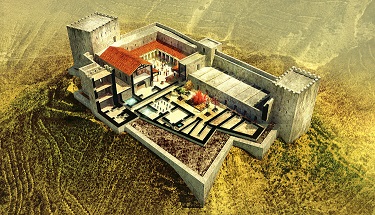

Location: Madaba Governorate Map
Constructed: 103- 76 BC
Abandoned: 72 AD
Machaerus Palace is a fortified palace constructed on top of a strategic hill by the Jewish king Alexander Jannaeus in 103- 76 BC according to history of Josephus Flavius, Jewish historian. A site for its construction was chosen in a secluded oasis to the east of the Dead Sea, on the Moabite plateau. According to New Testament John the Baptist was kept here for 2 years until he was beheaded by the orders of Herod Antipas, son of Herod the Great (this family had a lot of imagination when it came to fist names). Machaerus Palace was built on a site of a rocky hill that is hard to access from the bottom. It was further strengthened by a moat that was dug around the perimeter. Hundred years later another king Herod the Great further increased defenses of his palace. He was paranoid about his position and hence security was a key in many of his building projects including Machaerus Palace. He increased living quarters of the palace. Little was preserved over a course of centuries, but we can guess its size by the enormous size of water cisterns that were laid under the Machaerus palace and supplied it with water during sieges.
Machaerus palace also served as a political prison due to its seclusion and thick walls. Even if inmate succeeded in escaping from the cell, he/ she wouldn't make it too far across barren landscape. Prison cells are still visible today. They were dug into a cliff side so they survived despite centuries of tribulations and neglect. One of these prison cells held prophet John the Baptist for two years. According to New Testament he was arrested for his sermons that denounced Herod's wedding to his wife Herodias. Eventually he was beheaded upon orders of Herod Antipas (son of Herod the Great) around 30AD.
Just few years later Machaerus palace was stormed by the Roman troops under leadership of the Roman legate (officer) Lucilius Bassus in 72 AD in the course of the Jewish War 66- 73 AD. Apparently the Romans used the same siege technique in Machaerus as they did at Masada, Israel. They constructed a huge ramp to deliver siege weapons to the top. Jewish rebels undertook a daring raid against the Roman camp destroying Roman siege weapons and making attack impossible. Eventually legate Lucilius worked out a deal with the defenders of Machaerus. They were allowed to leave the citadel, but the former royal palace was turned down for good. Only foundations were left on a site of a former luxurious royal retreat.